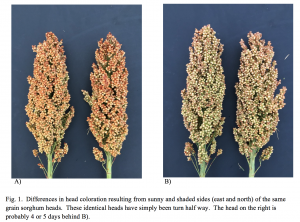This tip was provided by:
Calvin Trostle, Extension Agronomy, Lubbock, 806-746-6101, ctrostle@ag.tamu.edu
Statewide
Sorghum Physiology & Management V
This is the final article of five Sorghum Tips from Texas A&M AgriLife since last fall. The previous Tips are available at http://texassorghum.org/sorghum-tips, and cover the following topics:
- Sorghum planting pattern may affect later brace root development and standability pending sorghum planting in a furrow, flat, or on an elevated bed.
- Location of sorghum roots near the soil surface and N fertilizer application.
- Keys for optimizing grain sorghum production due to growing point differentiation.
- Environment and feeding insect potential may influence hybrid choice of panicle type.
Physiology Driven Sorghum Management Consideration #5:
- Mistake: Associating developing grain color with maturity.
Too often farmers may draw incorrect conclusions about grain development and maturity based on observations from around the field without checking grain maturity. Any producer should know that among different grain sorghum hybrids there is variation in mature grain color, and not all grain will achieve the obvious red or orange color (let alone a crème or white grain) that might be assumed to represent maturity.
Our observation is that when the seed in the head begins to take on an orange or reddish tint, the seed is most likely still at the milk stage. As a sorghum field develops further color that you readily observe from the edge of the field or passing by from a distance then the sorghum grain tends to be intermediate between milk stage and soft dough (we call this ‘mealy’ or ‘gel’ stage; pressing the seed with finger and thumbnail no longer produces any liquid, but seed contents are squeezed out). Some producers erroneously use field grain color as a gauge for one last possible irrigation if available, but this is not a reliable means of deciding to irrigate again. You must check grain stage of development and probe for remaining soil moisture. Mature grain is never defined by grain color, but by black layer development, which can vary by up to seven days in a larger panicle, and up to seven days between a primary panicle vs. a tiller panicle.
Furthermore, the direction which you observe a maturing sorghum field’s grain color may lead one to a different conclusion about the development of a field. Typically, sorghum panicles color more quickly on the sides facing the sun (Fig. 1A&B).









